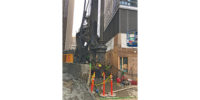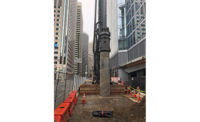Engineers paused work for at least two weeks on the $100-million foundation upgrade for San Francisco's 645-ft-tall Millennium Tower high-rise residential condominium after measurements showed increased settlement during the installation of pile casings for the new piles.
The work has been stopped "out of an abundance of caution" for two to four weeks, said a statement from Ronald O. Hamburger, the senior principal with Simpson Gumpertz & Heger, who designed the upgrade scheme. The pause, which began Aug. 20, will allow the engineers "to understand better the mechanisms associated with the increased settlement rate" and ways to mitigate it, he explains.
The building remains "fully safe" and unharmed, says Hamburger.
The tower settled about 17 in. since its completion in 2008. Work on the sinking 58-story building to prevent significant future settlement, financed by a court settlement, began last fall.
The pile scheme calls for transferring a portion of the building’s weight to bedrock from its existing foundation system. The fix, likened to putting a bumper jack next to a flat tire, relies on drilling and jacking 52 concrete piles—socketed more than 30 ft into the bedrock that starts 220 ft below grade—under the sidewalks of Mission and Fremont streets. Piles would support a new mat section, known as a collar, tied into the existing mat.
Shimmick Construction is the contractor for the pile upgrade.
During the work, engineers have been keeping a close eye on the building's settlement and tilt at the roof. They also have been monitoring ground and groundwater conditions. Sensors and measuring devices collect the data and reports are issued weekly by an engineering firm.
Geotechnical Engineer John Egan, of SAGE Engineers, has issued a series of memos about what he has found after review of the data. In his June memo, Egan wrote that during the month in which the pile casings have been installed, "there has been settlement with the largest amount near Fremont Street where the casing work is being done."
Egan theorized that during pile casing installation "vibrations from the pile rig and from insertion and cleaning of the drill casings may be producing small amounts of densification of the Marine/Colma sands below the tips of the existing concrete piles that support the tower.”
Marine sands are found in the San Francisco Bay area beneath the bay mud layer at depths between 35 ft and 65 ft. Colma sands are yellowish/orange and are found at depths from 35 ft to 110 ft.
The measurement of the building's position and tilt are being closely scrutinized with each phase of construction.
Settlement and Roof Tilt Changes
On June 14, Egan noted that the tower settlement rate had increased from roughly 1/8 in. a year to 1/4 in. a year starting in late January 2021 until early April. The increase coincided with the set-up and installation of the indicator piles. But the rate of settlement had been greater in prior years.
In the month beginning in mid-May when installation of the pile casings along the Fremont Street alignment was taking place, the average settlement of the tower has been about 1/16 in., or 7/8 in. per year, Egan reported.
Since construction work began in November, the tilt of the tower has also increased, Egan wrote. "Similar to the settlement observations...different amounts and rates of tilt increase correspond to the various periods of construction activity described above." For example, "one measure showed that lateral deflection at the roof level ... has increased slightly less than 2½ in. toward Fremont Street and about ⅓ in. toward Mission Street."
Hamburger predicts that once pile installation is complete, and loads are transferred to the new piles, "the building will experience substantial improvement and begin to recover some of the tilting that has occurred over the year."






Post a comment to this article
Report Abusive Comment